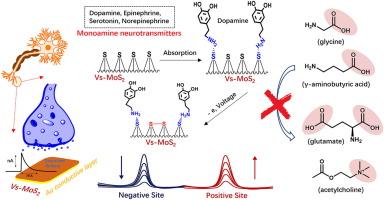Stoichiometric inhibition of sulfur oxidation Triggers dual signals for electrochemical Ultrasensitive detection and visualization of monoamine neurotransmitters in MoS2
IF 13.3
1区 工程技术
Q1 ENGINEERING, CHEMICAL
引用次数: 0
Abstract
Monoamine neurotransmitters play a key role in regulating neural circuit dynamics, and their imaging and monitoring provide crucial insights for comprehending neural function and diagnosing diseases. However, the current signal generated through the direct electrochemical oxidation of neurotransmitters makes it challenging to achieve their imaging and reliably quantify neurotransmitters at low concentrations. Herein, we introduce a unique electrochemical sensing signal produced by the stoichiometric inhibition of S oxidation in MoS2, enabling highly sensitive detection and imaging of monoamine neurotransmitters. The surface S near the defect easily oxidized to produce electronegative −S-S- species under potential, thereby generating a strong current and Raman signal. However, the uptake of stoichiometric monoamine neurotransmitters at the S sites, driven by intermolecular forces, inhibits this oxidation, thus quenching this current and Raman signaling response. This response occurs even at ultralow concentrations (femtomolar level) and effectively excludes interference from amino acid neurotransmitters and other biomolecules. By employing potential-driven Raman mapping, monoamine neurotransmitter can be directly visualized. Furthermore, its high temporal resolution is demonstrated by PC12 neuronal cells achieving rapid synaptic transmission via quantal release within a 50 ms time scale.

求助全文
约1分钟内获得全文
求助全文
来源期刊

Chemical Engineering Journal
工程技术-工程:化工
CiteScore
21.70
自引率
9.30%
发文量
6781
审稿时长
2.4 months
期刊介绍:
The Chemical Engineering Journal is an international research journal that invites contributions of original and novel fundamental research. It aims to provide an international platform for presenting original fundamental research, interpretative reviews, and discussions on new developments in chemical engineering. The journal welcomes papers that describe novel theory and its practical application, as well as those that demonstrate the transfer of techniques from other disciplines. It also welcomes reports on carefully conducted experimental work that is soundly interpreted. The main focus of the journal is on original and rigorous research results that have broad significance. The Catalysis section within the Chemical Engineering Journal focuses specifically on Experimental and Theoretical studies in the fields of heterogeneous catalysis, molecular catalysis, and biocatalysis. These studies have industrial impact on various sectors such as chemicals, energy, materials, foods, healthcare, and environmental protection.
 求助内容:
求助内容: 应助结果提醒方式:
应助结果提醒方式:


